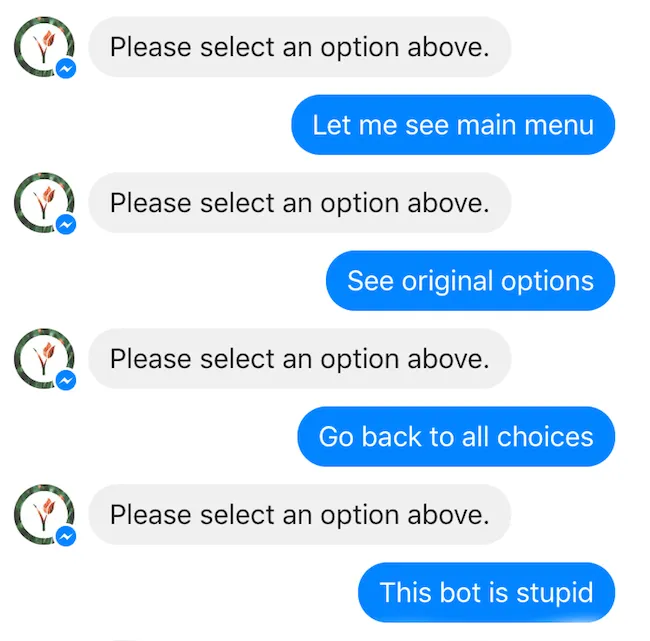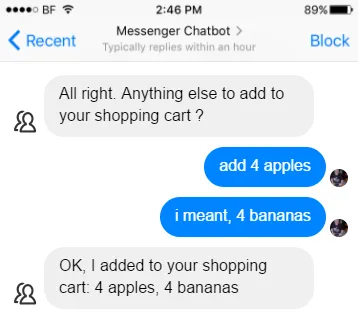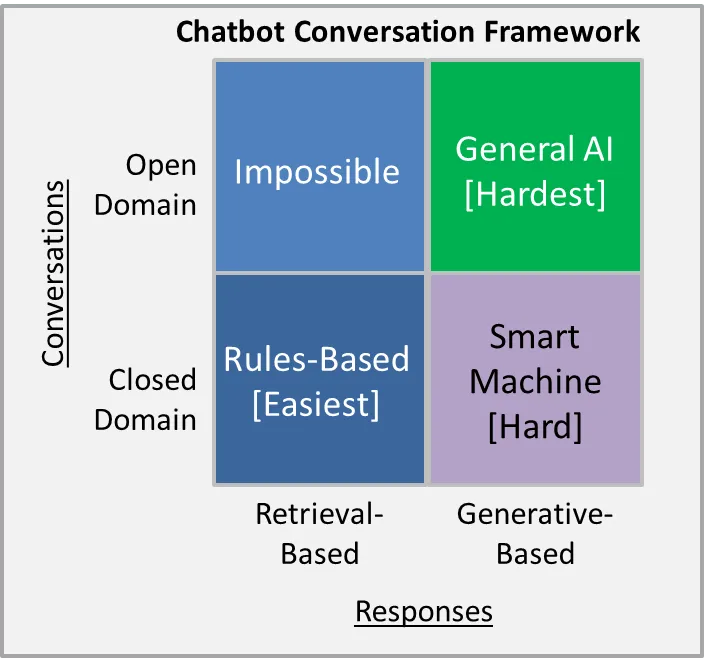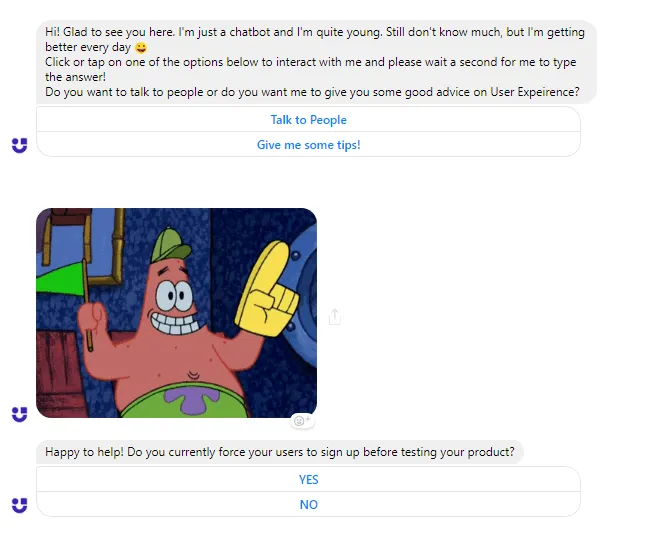Can You Onboard New Users With Chatbots?

Chatbots can be very useful even though they sometimes fail and make us laugh or generate frustration.


Image sources: Image 1, Image 2
I’m pretty sure you’ve had both good and awkward experiences with chatbots as well. Some people say that chatbots aren’t fully capable of replacing human beings in a normal conversation yet.
Even if it’s true that conversational bots still need to be able to fully encrypt the different facets of our language to become fully efficient and pass a superficial Turing test, they’re nonetheless pretty useful when it comes to customer support.
There are plenty of different applications for bots. For example, they’re quite practical in messenger apps and can be deployed to take an order or quickly respond to a customer in a Facebook chat or to resolve an issue via live chat on a website without human intervention.
The main advantages of chatbots are represented by the fact that visitors receive an immediate reply to their queries and that they can reduce the workload from customer support.
Bots are always on duty and can be triggered to start a conversation with a website visitor at the right time and clear up doubts even before the prospect is forced to look for additional information on other pages.
Especially when it comes to website visitors, chatbots do a very good job in drawing the attention to the product and push users to look for more information or go for a trial.
Table of Contents
General Constraints of Chatbots
Chatbots have some limitations as well.
Sometimes, bots are simply incapable of finding a solution to a problem.
Therefore, in order to avoid frustration, smart chatbots should also be programmed to recognize their own limits and redirect people to other applications or to actual human beings to guarantee an acceptable level of customer support .
On top of that, when implementing chatbots, companies also need to deal with constraints which are connected to the fact that AI is still not fully able to interact with human beings and understand subtle messages that can hide between the lines.
The road to actual conversational AI is still bumpy.

We all use different terms to refer to similar concepts and even if very efficient bots are programmed to be familiar with different ways of phrasing the same idea, there are always fringe users who choose a very unique wording for their queries or even wrong technical terms.
The effect, in this case, is just confusion. A chatbot might interpret a question in the wrong way or not understand the question at all. As mentioned, this quickly leads to frustration and to your company missing on a potential opportunity.
You can avoid such problems by creating predefined answers or questions that the user can choose from. Bots that present such a pre-selection of options are not as interactive as bots that implement AI to decode natural language, but can be a temporary solution to implement while conversational bots become more accurate.

Here are some other limitations and caveats connected to chatbots you need to be prepared to deal with:
- Understanding corrections and coping with people who change their mind is still an issue
- Dealing with users who need time to formulate their questions properly can create confusing answers
- Suddenly changing the topics of the conversation and moving on to another matter without any bridges is still beyond reach
- Your use case is not the optimal situation for chatbots
- Lack of transparency can create confusion. You need to make sure that users know that they’re chatting with a bot from the very beginning
- Bots need context. They still can’t extrapolate concepts from a conversation without a proper framework
- They need to be perfectly integrated with other applications to allow customers to move along their journey
- Bots are generally good at doing one thing and one thing only…trying to use them as a general purpose solution can have devastating effects on user experience
Chatbots and User Onboarding
As a SaaS provider, can you use chatbots for onboarding new users and potential customers?
A short answer to this question is: “You can, but chatbots aren’t the best solution for this“. But let me explain why I think that onboarding new users is not the strongest case for chatbots.
A few people wonder if chatbots can support users during the onboarding phase and this may be the case, but this choice is connected to several risks and flaws thatLearn more about employee training and support are better suited to cope with.
Onboarding new users is extremely critical since you only have a very limited amount of time to make a good impression.
At this stage, a user will decide on whether or not your service is useful and actually adds value and if it helps them move toward their own goals.
I can’t stress that enough, the onboarding phase is the decisive step that will set the mood for the entire relationship between a customer and the brand.
Therefore, onboarding has a very deep Impact on conversion rate, activation and retention.

Users who feel stuck or frustrated when trying to accomplish first tasks within a piece of software or while attempting to set up the whole environment to be productive within your application will quickly churn.
Successful SaaS companies know how important it is to guide new users during this delicate stage and implement different tools to support them long the discovery journey.
But to understand on whether or not chatbots are the best solution for this purpose, let me first ask you a question: I’m not a connoisseur and maybe you’re not a fan of rap music in general either, however, can you tell what the difference between a great rapper and a mediocre rapper is?
The main difference is their flow.

In poetry or rap music, a great flow is when words are seamlessly interconnected to each other and create a fantastic journey that brings the listener from the very first syllable to the punchline without any hesitation, stuttering or awkward jumps.
A good flow is entertaining and unexpected at times. It’s surprising, energetic and dynamic. It addresses and moves the listener while pushing them throughout walls of words and rhythm making it easy for them to follow along. A rapper can take their listeners along their own journey as if they were surfing a wave in an ocean of words and ideas and you’re taken by the hand throughout the whole discovery journey.
A bad rap song is just a series of sentences that doesn’t actually go anywhere.
A constant flow is self contained, meaning that it provides all the elements that allow the listener to get from A to B without any additional support in decoding concepts and phrases.
This analogy works really well for describing a great onboarding experience.
A great onboarding flow doesn’t present any interruptions or gaps. As soon as the user is forced to leave the application and interrupt their journey to go and look for additional information they’re already lost and probably will feel hostile towards your application.
One of the classic examples of inefficient onboarding is when companies rely on video tutorials or FAQs to guide customers who are trying new software.
Other companies try to support users within the application via live chat where either a human or a bot replies to queries and questions.
Chatbots or live chats in general certainly represent an improvement in comparison to other external sources of support. Surely, the worst case scenario is when users are stuck and can’t perform a particular task and need to rely on community support while being forced to go to forums to look for answers.
In some cases, similar communities even need to be found outside of the platform. Video tutorials and FAQs are at least hosted on the same page and a live chat is easy to access within a software solution.

Yet, abandoning a process to go and type question and wait for an answer is an interruption in the onboarding flow. As mentioned, the onboarding process needs to be frictionless and fast because the sooner a user is successful with your software solution and experiences a win the better they feel about your product and immediately realize what the benefits and advantages of your application are.
Any disruption in the onboarding flow is immediately connected to frustration. Such inefficiencies are perceived as negative and instances of micro aggression pile up to generate frustration.
Additionally, engagement and activation are also deeply connected to how fast a user can successfully interact with a softer solution.
Proactive Customer Success Management Tools
One of the main drawbacks of chatbots is connected to the fact that customer success management tools are divided into two categories: proactive and reactive.
A live chat is a form of reactive customer support tool. This means that the user encounters a problem or has a question and then they actively look for a solution.
Effective proactive support tools, should actually prevent the user from dealing with the problem or having doubts in the first place.

When a user has a problem and needs to look for a solution it’s already too late! It means that you didn’t implement the necessary proactive measures to prevent the user from looking for help.
Users can’t ask Questions about Features They don’t know You offer
One of the most important aspects of a trial is getting to know all the key features of an application. And such features can be used to surprise potential new customers.
Let me give you a quick example. A couple of days ago, I grabbed my phone to send a message. I was at home. As usual, I unlocked my screen with a code when, suddenly, the system prompted me with a new feature I was not aware of. It asked me if it was okay for me to bypass the unlocking screen step if I was at home or in the proximity of my home wi-fi connection.
This means that when I’m home, I can just take my phone, take a pic or send a message immediately without being forced to enter a code and unblock my phone every time. When leaving a specific area (defined in feet) around my place, then, the screen goes back to being locked.
Firstly…how awesome is that? Amazing user experience as always, Android ! 😉

Secondly: I was absolutely not aware of such a feature. Therefore, it would have never popped into my head to go and ask Google if it was possible to leave my phone unlocked while I’m at home.
That’s exactly what happens if users are not onboarded interactively. They can’t be surprised by those specific features you implemented to create an outstanding user experience and they’ll never even imagine that your solution entails such functions.
Unless they ask a very specific question, chatbots will never present them such features and you miss on the opportunity to wow your users!
Why Interactive Onboarding Tours are better than Chatbots
You may obviously think that we’re biased when we say that the only way to onboard new users efficiently if offering themLearn more about employee training and support within the software application itself.
But the process is actually inverted. We’re not advocating onboarding guides as optimal solution because we offer our clients the opportunity to create such interactive walkthroughs. The truth is that we initially did our homework and carried out research that led us to identify the best onboarding solution and then we created our editor for creating onscreen floating guides.
We worked with experts in user psychology and surveyed several users before realizing that onscreen guides and direct guidance within the software represent the most beneficial way to create a great onboarding flow linked to an exceptional user experience.
With onboarding guides, everything happens within the application itself and users are steered through all the processes interactively and in real time.
Our product takes into account every single kind of user, from the most tech-savvy to fringe users who aren’t familiar with any kind of cloud applications.
Our onboarding tours include conditional steps. And this is important, because your onboarding process needs to be customized and optimized for every person individually since you can’t take for granted the fact that every user has the same background and technical skills. Chatbots, in this case, can’t help.
Onboarding tours ensure a frictionless onboarding process that always leads to customer success and eventually to a much higher conversion rate, more engagement, activation and retention.
Learn more about employee training and support

